North Staging

Our tour starts at the northern and eastern most point of the layout. The North Staging Area accomodates ten staging tracks of which three are continuous loops; the other seven are stub-ended. Two more non-staging tracks form continuous loops around the staging area for the turning and temporary holding of trains.
Trains departing from North Staging are typically computer-controlled (but can also be manually controlled). Python scripts coded to work with the Java Model Railroad Interface (JMRI) route trains out of staging, and stop them at a signaled train order board located just outside of staging. Operators are given their train orders and take over control of their train at this point.
Train Order Board
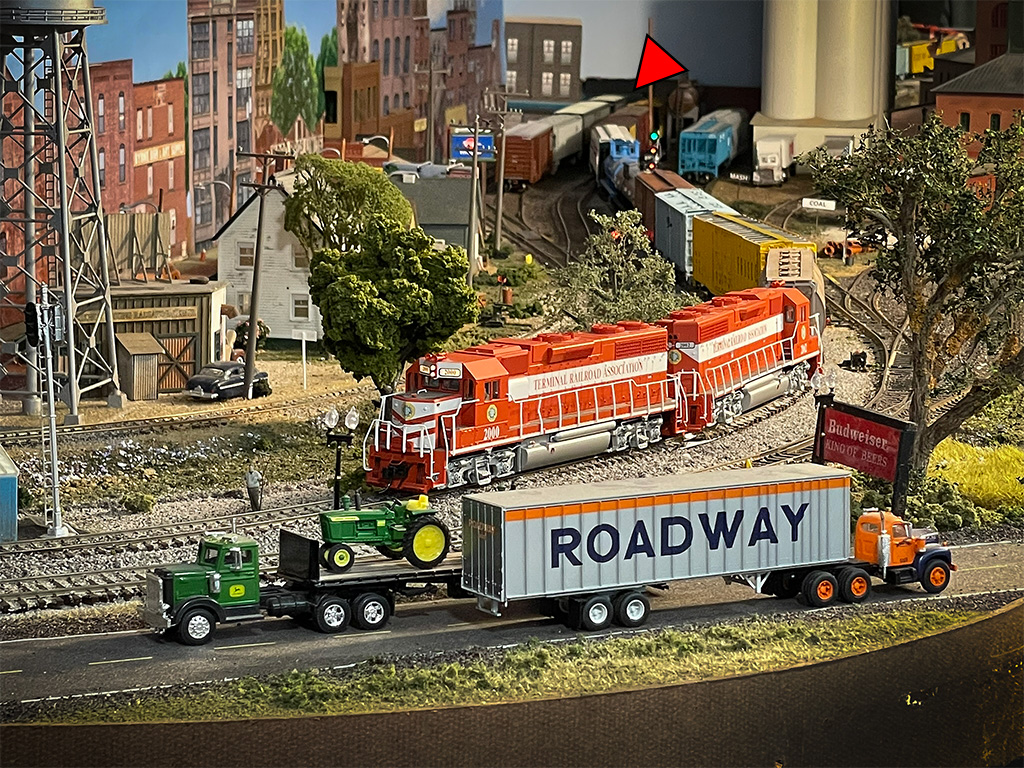
This is where crews for trains departing North Staging take over control of their trains. The signal is set to red by the same Python script that moves the train out of staging. The dispatcher clears the signal from the simulated JMRI-based CTC panel once the train operator has their orders.
As we continue our tour, keep an open mind. Although the layout was heavily inspired by the operations of St. Louis railroads during the nineteen-seventies, it does not claim nor pretend to be correct to the prototype in every way. You can consider the layout a work of historical fiction in many respects.
Soulard Neighborhood
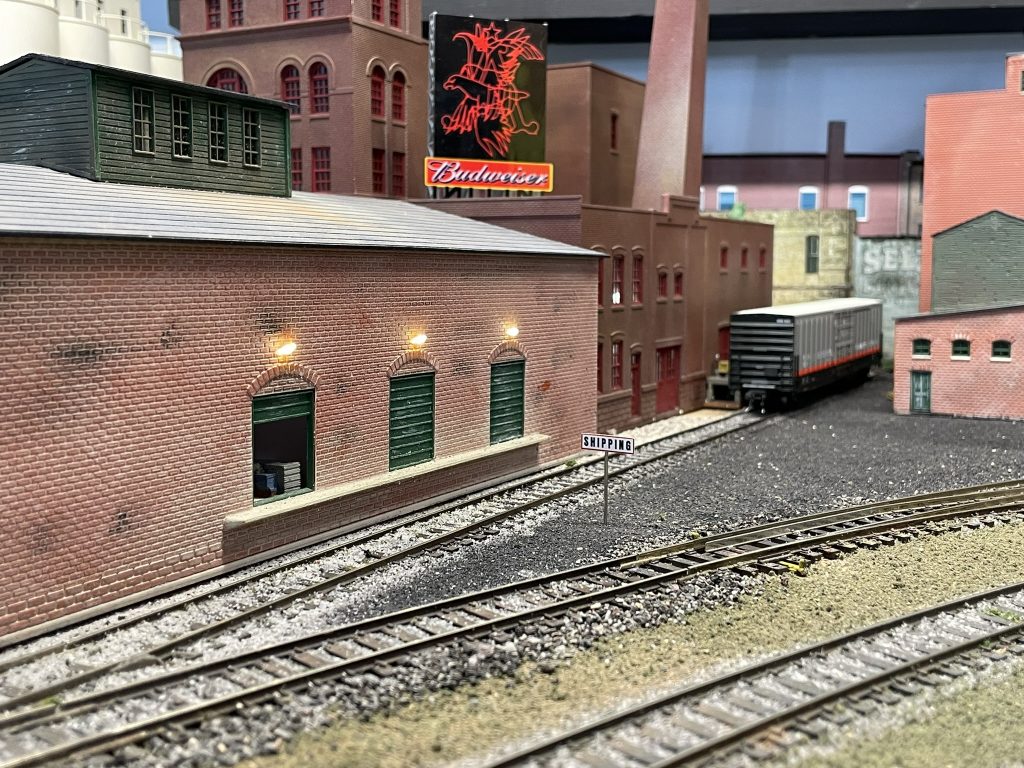
Soulard and Baden are the two primary switching areas that are located on the upper level of the layout.
The Anheuser-Busch brewery located nearby keeps crews busy during an operating session. Commodities handled by train for this plant include finished bottled and canned beer, returned empty kegs, empty bottles, bottle caps, packaging materials, grain, broken glass (cullet), diatomaceous earth, spent grain (mash), hops, and coal.
Baden

Baden is the next switching location down the line. Those persons familiar with St. Louis and neighboring communities know that Baden was located North of the City of St. Louis. A bit of “modeling license” was used to locate Baden where it is on the layout. This area is home to a street department, grain elevator complex, propane dealer, and farm supply operation. It is served by the Missouri Kansas Texas (MKT, Katy) railroad. Trains with no work in Baden may take the High Line to bypass this location.
LaSalle Park

The first community encountered as trains departing North Staging reach the lower level of the layout, is LaSalle Park. The two hubs of activity in this area are Purina Mills and 12th Street Yard.
Checkerboard Square – Home of Purina Mills
The Terminal Railroad of St. Louis (TRRA) serves this plant, which is a manufacturer of various animal chows (feed). A crew of two operators is required to efficiently work this industry. One side of the plant receives raw materials, while the other side ships finished product in both boxcars and covered hoppers.
12th Street Yard

This classification yard, used by both the Alton & Southern and Missouri Pacific Lines, serves other small industries in LaSalle Park. This includes an appliance distributor, seed company, wholesale grocer, and
Coca-Cola bottling plant. The yard also serves as a connection point for trains from the Anheuser-Busch brewery.
Tower Grove

Continuing southbound, we reach the Tower Grove neighborhood, where a cement factory, quarry, and a ready-mix plant keeps a crew occupied during a session. A couple of the features here include a simulated loader and track scale. For operating interest, crews are required to weigh both empty and loaded covered hoppers, as well as start the loading sequence for each hopper entering the cement loader. A small dedicated industrial yard is also a part of the operations here. Commodities moved by rail in this area include concrete, aggregate, additives, coal, explosives, fuel, lime, and bagged cement.
Lindenwood Yard

Lindenwood is the largest and busiest of the three operating classification yards on the layout (12th Street & Ivory Yard are the other two). The yard is visited by transfers from Missouri Pacific, Alton & Southern, Terminal RR of St. Louis, Missouri-Kansas-Texas, Southern, and the fictitious Calico & Turpin Springs railroads during operating session. Frisco manifests and three local (zone) switch jobs originate from and/or terminate at this yard.
Ellendale (Zone 1)

Just outside Lindenwood Yard, the prototype Frisco railroad’s team track was located in the Ellendale neighborhood. In addition to the team track, we’ve taken the liberty to add a Lammert Furniture Warehouse, a propane dealer, and a metals fabrication plant.
Shrewsbury (Zone 2)
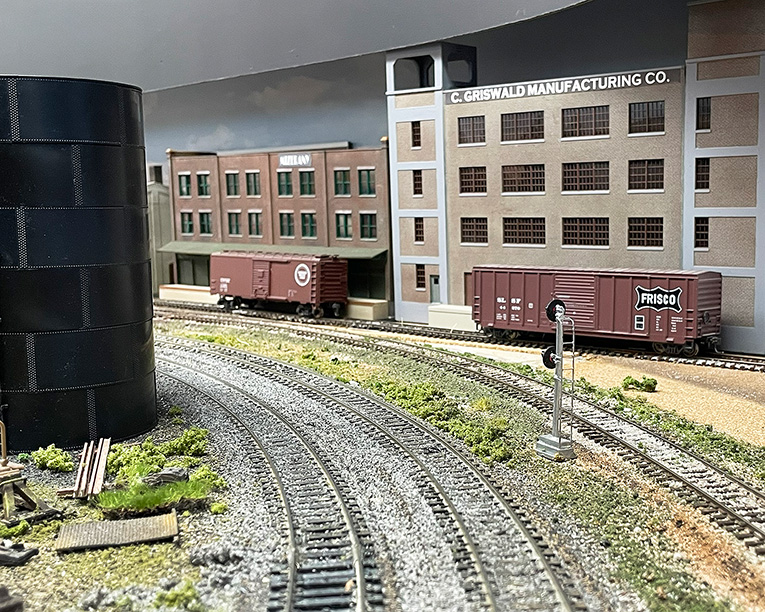
The Shrewsbury neighborhood is also close to Lindenwood Yard. On the layout, the rail-served customers located here are Ozark Paper Box Co, Mizerany Warehouse, Griswald Manufacturing, Kroger Bakery, and Cupples Manufacturing.
Chouteau Switching District (Zone 3)

In this small switching district, layout customers include the Spring Avenue Team Track, a Central Hardware distribution center, a lumber yard, and a fruit & produce wholesaler.
Carondelet
Located near the confluence of River Des Peres and the Mississippi River, Carondelet was once a thriving industrial district. Many years ago, two very large Iron Works (Jupiter and Vulcan) employed thousands of workers. A Marine iron works once produced numerous ships here. On the layout, we’ve located US Steel, Bendix Corporation, and Pillsbury Mills in this area.
US Steel
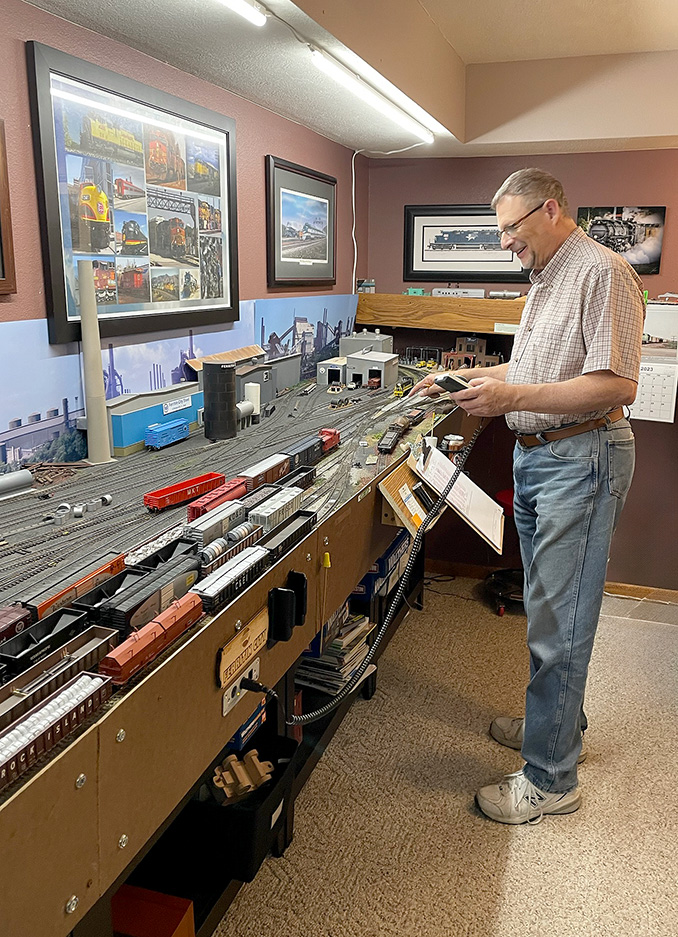
The principal raw materials for an integrated mill are iron ore, limestone, and coal (or coke). These materials are charged in batches into a blast furnace where the iron compounds in the ore give up excess oxygen and become liquid iron. There isn’t enough layout space to represent the receiving of massive iron ore shipments, so we were not able to model that. Our modeled plant receives coal and lime loads, but not in the quantities that a prototypical plant would.
The plant also receives boxcars loaded with various materials and supplies, tank cars of diesel fuel to
power the yard goat, and gondolas loaded with tons of rusty old scrap metal. (We recycle here.)
Empty coil cars and gondolas are constantly flowing into the facility, and sent out with loads from the
rolling, pipe, and wire mills located on the property. Slag, which occurs as a molten liquid melt and is a
complex solution of silicates and oxides that solidifies upon cooling, is shipped from the plant in open
hoppers. Other outbound shipments includes bags of various chemical products created as a by-product
of the operation, and tank cars of coal tar, another by-product of production.
Slag is a residue is comprised of minerals such as silica, alumina and titanium from iron sand, as well as
other combinations of calcium and magnesium oxides derived from other raw materials. It is often used
as a road base. With high particle density and hardness, slag has superior wear resistance, which makes
it an excellent aggregate for asphalt concrete. Other applications of slag include rail ballast, soil
conditioner, sewage treatment and even artificial ocean reefs.
Coal tar, a black, sticky liquid thicker than water, is produced when coal is heated in the absence of air, a
process called destructive distillation. Much coal tar is produced by the steel industry as it produces
millions of tons of coke each year to fuel the furnaces used in separating iron from its ores. Uses for
coal tar are numerous, and include everything from industrial electrodes to medicinal shampoos.
Pillsbury Milling

“Nothin’s as lovin’ as something from the oven”, and there’s always something baking in the oven at
the product testing building; most days you can smell the tantalizing aroma for miles. The shipping part of operations is all we had room to model. Covered hopper loads of flour and sugar are shipped daily, so there’s always the need for empty covered hoppers at the plant. Cake mix, muffin mix, pancake mix, and donut mix is shipped out in boxcars. Crews working the plant like to stop by the test kitchen for free samples whenever working this plant. The actual Pillsbury plant in St. Louis was located just north of the downtown area. Present day Carondelet is the real home and headquarters of Italgroni, which mills large quantities of semolina and durum flour at this St. Louis plant.
Laclede Landing

No locomotives allowed!
Students of St. Louis history know that Laclede Landing was named for the location where Laclede and his entourage reportedly first came ashore on the western bank of the Mississippi. The layout reallocated the location name as a place to moor a railroad car float. (Ste. Genevieve, fifty miles down-river from
St. Louis, hosted a railroad car ferry for years, but I am not personally aware of any car floats or ferry operations on the St. Louis riverfront in the niineteen-seventies. By then, bridges carried all the rail traffic headed east out of St. Louis.) The car float located here on the layout adds to operational interest for crews, which typically either load or unload the float once during any session. Cars for this job are coming from or going to Ivory Yard.
May 2024 Update – The car float has been replaced with a larger Pillsbury Plant, and this area has been annexed by Carondelet. Laclede Landing and the car float operation are gone. See this blog post for more information on the changes.
South Staging
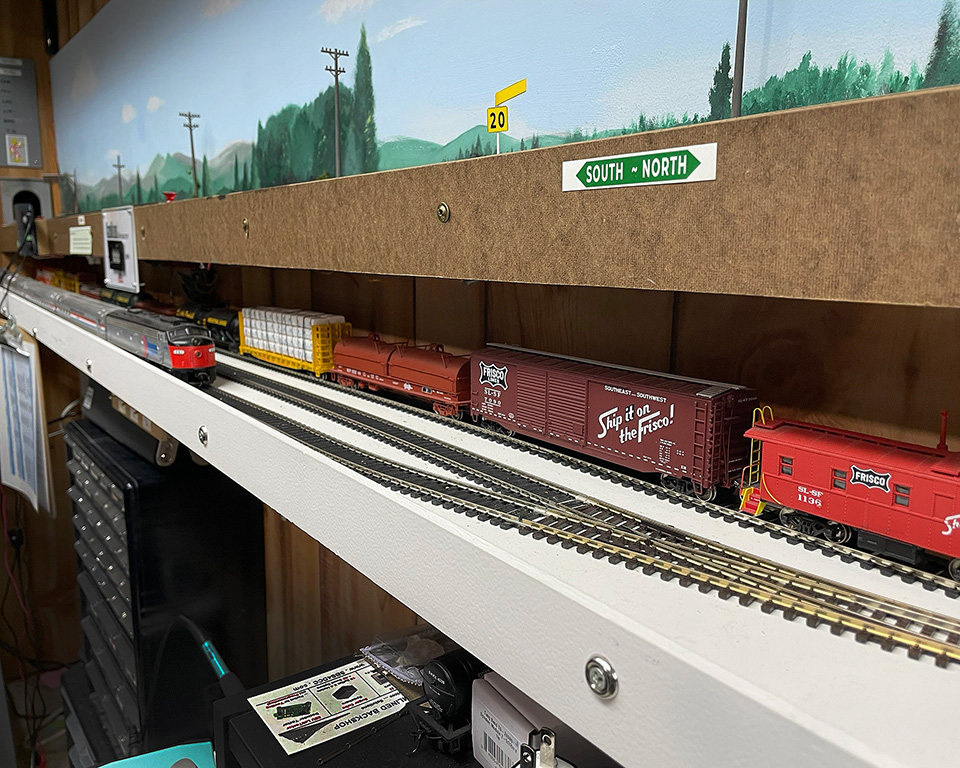
We end our layout tour at South Staging. The compact South Staging tracks were added in 2023. Three trains are staged here at the start of each session,
- Track 1: a northbound Frisco manifest (#222) out of Tennessee Yard in Memphis.
- Track 2: a northbound Southern Railway manifest out of Louisville, Kentucky
- Track 3: an eastbound Amtrak Anne Rutledge (departing Kirkwood, Missouri for downtown
St. Louis)
If all of the three trains run, at the end of a session,
- Track 1: the southbound Frisco manifest #333
- Track 2: the southbound Southern Railway manifest
- Track 3: the westbound Amtrak Anne Rutledge headed for Kansas City
Oops, one more stop before we end our tour…
The Dispatcher’s Desk – CTC Board
Centralized Traffic Control, or CTC, is a system used to control train routing on a railroad. A person known as a Dispatcher controls this routing from a panel of levers, push buttons, and indicators. From this control panel, or CTC Board, the Dispatcher can keep track of the trains in their territory by ascertaining which blocks are occupied and which blocks are open. Our dispatcher also has control over track-side signals that control train movements between single track and double track territory (e.g. a passing siding).
The CTC panel on the Saint Louis Lines is an electronic representation, createdd in JMRI – A Java Model Railroad Interface.
Want more information on CTC panels in model railroading?
Several publications on CTC have appeared in the model railroad press over the years. A few of them are:
- How to OPERATE your model railroad, by Bruce A. Chubb, Kalmbach Publishing Co., ISBN 0-89024-528-2
- “Centralized traffic control for the Sunset Valley”, by Bruce Chubb, Model Railroader, January 1984, pages 186-193.
- “Centralized Traffic Control for the Cat Mountain Line”, by Ken Thompson, Model Railroader, May 1984, pages 74-80.
Additionally, the Logic Railtech website has a basic discussion of how a CTC panel works.

Visit the Gallery pages for more images of the Saint Louis Lines.



